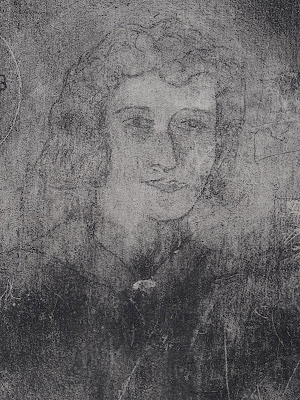ARTISTS IN LOVE, part eight

Edward Galinski, a Polish student, scratched this portrait on the wall of cell 18, block 11, at Auschwitz.
Edward was imprisoned by the Nazis in 1940 for opposing Germany's invasion of Poland. He worked at forced labor in the camp. One day, Edward was assigned to repair buildings at the women's camp next door. There he met Mally Zimetbaum-- a beautiful, doe eyed girl imprisoned for being a Jew.
Edward was completely smitten. He started talking with Mally under the watchful eye of the guards. After several weeks of furtive exchanges, the couple found a way to pass secret notes back and forth between the two camps. Against all odds, through the barbed wire and brutal guards, love bloomed.
Edward realized that Mally would eventually be killed in the gas chambers, so he came up with a daring escape plan. On June 24, 1944, he put on a stolen SS uniform and escorted Mally through the front gates using forged paperwork and passes that Mally had obtained. Once outside the camp, they disappeared into the tall grain and headed for the Czech border.

In his book about Auschwitz, Polish author Wojciech Kielar wrote that when the escape was discovered, every prisoner in Auschwitz spoke about nothing but Edward and Mally. The young couple in love became a symbol of freedom and hope for a new generation.
Edward and Mally had twelve days together. It would have to be enough.
Mally was captured by a German patrol at the Czech border. Edward was safely in the clear, but when he saw that Mally had been captured, he returned and surrendered to be with her. Back at Auschwitz, Edward and Mally were thrown into isolation cells in the basement of block 11. There they were tortured for details of their escape and the names of any accomplices. Another prisoner in block 11, Zbigniew Kaczkowski, recalled that Edward had a secret way of checking at the end of each day to see if Mally had survived: "Every night, pressing his lips to a crack in the door, [Edward] would whistle a certain melody; he would get a reply, the same melody from Mally in a distant cell."

Edward was held in cells 18, 20 and 23. There he paced, desperate and helpless while his beloved Mally was tortured down the hall. In each cell, he drew a portrait of Mally on the wall and wrote their names together.

Edward and Mally never did betray their helpers. Their captors executed them in front of the entire camp to discourage future escapes. Edward was hung from the gallows in the male prison yard. He shouted his last words, "long live Poland," with the noose around his neck. One historical account recalled that at the moment of his death, "an anonymous voice shouted out from among the prisoners: 'Hats off!' and the entire camp, as one, removed caps in a defiant salute." Mally tried to kill herself on the gallows but was intercepted and stomped to death by SS men in front of the women prisoners.

I would like to say two things about the sad story of Edward and Mally.
The first has to do with the role of art. I find it strangely moving that human beings turn to pictures for solace in times of great distress. When the woman he loved was being tortured down the hall and there wasn't a thing he could do about it, Edward drew a picture of her face. There is no logical explanation for this. Why should lines scratched on a wall make him feel closer to Mally? Images contain powerful magic, even at the outer extremes of bearable human experience.
My second point is about-- for want of a better word-- love. Sometimes I think about what Edward and Mally were able to condense into their twelve desperate days of freedom.
Rabindranath Tagore once wrote, "the butterfly counts not months but moments and has time enough." Generally I take little comfort from this because humans are different from butterflies.
But in the case of Edward and Mally one hopes that whatever they shared during those twelve days was enough to sustain them during the ordeal ahead. Years ago Richard Kennedy wrote a fairy tale called the Dark Princess, about two would be lovers, a princess and a jester. The two could never have a life together. In fact, they could not even look at each other or talk to each other. The sum total of their life together was one brief moment as they jumped off a cliff and were able to touch once before perishing in the sea below. Kennedy wrote the following about that touch:
And in that moment they touched, the sun rose a million times for them , and the Princess and the Fool could see each other and all the things of life and the world.... And that moment they touched outlasted the life of the King and Queen, and outlasted the life of the Kingdom. And that moment they touched is lasting still, and will outlast us, too.


